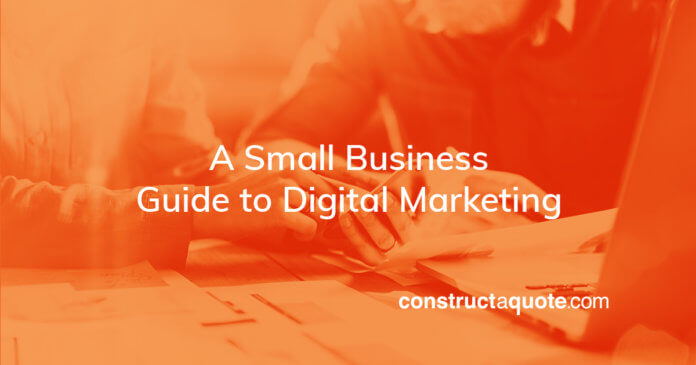by constructaquote - 10 April 2018


42% of small business owners admit they do not use a robust website or utilise social media channels to market their business.
Marketing could be considered as the most essential part of your business. Without a powerful marketing strategy in place, your company will fail to get in front of your customers.
Small businesses, especially start-ups, need to put even more emphasis on marketing compared to large companies that have already made a name for themselves.
This can seem like a daunting task for business owners and a challenge when it comes to allocating time and money for marketing. However, with advances in technology, it is now easier than ever for business owners to use digital marketing within their business. This guide will take a look at the most common digital marketing methods that small business owners can get to grips with quickly and start using today.
Every business wants to improve their sales. Whether you’re promoting your product/service directly to the customer to encourage them to buy it straight away or you’re playing the long-game by building up brand awareness first in the bid that they’ll buy from you later – the end goal to marketing is always to improve sales.
The key is to capture your customers’ attention with compelling content through advertising or social media, and then convert them into a customer. But, before we go delving deep into the four primary digital marketing methods that can be used to achieve this, we first need to ensure that we can capture sales via your website.
If you’re relying on your customers to find out more about you, purchase a product or book your service via your website, it’s essential that the website is working well before you carry out any marketing activities. If you start promoting your business and driving traffic to your site but the pages are slow, or the customer can’t find what they’re looking for – your marketing efforts have been wasted.
The aim of your website should be to provide the user with the exact information they are looking for regarding what you have to offer. It should also include clear calls-to-action that encourage the user to make a purchase or get in touch with you. Website user experience is crucial for customers to convert to sales.
When creating or improving your website, consider the following:
Once your website is up to scratch, you can then start focusing your efforts on any (or all) of the marketing activities below.
Over the last few years, social media has become the most common way for businesses to reach their customers. The beauty of social media is that it allows brands to promote their products for free, as well as communicate directly with their audience and customers while gaining instant feedback and suggestions.
Creating a ‘following’ on social media is essential as the more people you connect with, the more your brand becomes known.
While there are many benefits to using social media in business, the downside is that more and more companies have taken to the likes of Facebook and Instagram, therefore increasing the level of competition between brands online.
It is not enough for brands to continually promote their products anymore. Businesses now need to be savvier when building a following on social media and do even more to convince a customer to make a purchase. But it’s not impossible…
Brands that take the time to publish quality posts on social media will build up a quality audience of followers and potential customers. This can be done by:
If you really want to make an impact on social media, especially within a shorter period of time, you could use social media advertising or ‘sponsor’ your posts. This will allow you to target your audience based on their demographics and interests, forcing your product to appear in front of your desired customers.
Social media advertising costs will vary depending on how many people you want to target, but if you choose only one area of marketing to focus on initially, allocating a small monthly budget to promote your Facebook page could really improve your sales.
Each social media platform will require a different level of effort from you. Start off by using the one where your audience is active the most. Facebook and Instagram are the most common platforms for consumers, while LinkedIn and Twitter are more common for B2B’s.
‘Content is king’ has been a popular term amongst large companies over the last few years, but many small businesses still underestimate the power of content marketing.
Content can come in the form of blog posts, videos, images, guides, ebooks and infographics, and has several purposes in digital marketing.
Great content can catch the users’ attention in social media feeds and make them aware of your brand, which can then drive them to your website to find out more about what you offer and, ultimately, result in a sale.
The content you publish will depend mainly on your business type. However, the primary purpose of content should be to interest, inform, educate or entertain the audience.
For example, if your business is part of the fitness industry and someone searches “how to lose weight fast”, your content should appear in search results providing the user with an answer to their question. You’ve then got a potential customer on your website, aware of who you are and halfway there to becoming one of your customers.
Creating content that provides your customers with value will perceive you as the knowledgeable expert in your industry. This can build trust between you and your customer and serve as an advantage over your competitors.
With more content on your website, you’re likely to see an increase in the amount of organic traffic going to your site. This is because excellent content can improve your websites SEO (search engine optimisation) score, meaning you’re more likely to appear in search engine results.
However, while lots of content is great, it’s a case of quality over quantity, and the content you produce must be related to what people want to read or watch rather than lots of low-quality posts.
The power of content goes further than just a method to drive traffic to your website. The content you create for your site can also be used on your social media platforms, increasing the value of each piece of material you create.
While not all users will end up on your website buying your product or service, quality content has the power to increase your brand awareness long term and put your business at the forefront of potential customers’ minds when it comes to them needing what you sell in the future.
If you’ve got a marketing budget to play with, pay-per-click advertising could be an excellent solution to improve your sales.
PPC ads are the adverts you see at the top of the search results when you look for something online. They appear there because businesses have paid for them to feature there.
Through using a platform such as Google Adwords, businesses can create an advert for their product or service, set the type of audience they would like to target, add a budget to their campaign and then publish it online. Depending on the competitiveness of your industry, the cost of the results will vary. Niche brands with few competitors can gain awareness of their adverts for a low price, while businesses with lots of competitors will be required to pay more for their adverts to appear.
PPC can be easy to manage once everything is set up and you’ve got to grips with it. However, PPC can require a lot of testing initially and, depending on the type of business, some PPC campaigns may need a lot of management time. If this is the case, outsourcing it to an expert could be a good idea.
Email marketing can be a great way to keep in touch with your customers and notify them of new products and offers. It’s an effective way to drive sales to your website, as well as staying relevant in the recipients’ mind.
The success of email marketing varies from business to business. Some companies find it to be their most effective marketing method, while others don’t get great results.
The key to creating an effective email marketing campaign is to provide value to your recipients, either by informing them of something that you know will interest them such as a blog post or video or by informing them of an offer/competition you are running.
The subject line text is probably the most crucial element of email marketing as this is the first thing the recipient sees before making a decision on whether to open the email or move it straight to trash. Subject lines should be simple and straight to the point to improve the click-through rate of your email. Misleading subject lines could prevent them from opening any more mail from you in future.
The frequency of your emails is also an essential factor to consider as recipients may get annoyed with you emailing them all the time resulting in them ‘unsubscribing’. Less is more when it comes to effective email marketing, so choose wisely when deciding the topic of your emails.
Email marketing can require a lot of testing before you find what works for your business. But once you’ve established this, you can plan your emails in advance and set them to go out automatically. MailChimp is a great mailing tool with plenty of simple features and advanced options.
The new Government Data Protection Regulations (GDPR) will mean that businesses can no longer use their customer data in the same way as they do now. The new rules mean increased protection for data subjects (your customers, clients, third parties) and will require businesses to change the way they contact people. Users will now have to undergo a double opt-in process to receive your newsletters, so business owners should consider this when updating their website.
Whatever digital marketing method you choose, the key is to test things out, assess what’s working or not working, and then change the campaigns accordingly.
While many marketers will encourage small businesses to carry out as any marketing activities as they can, the reality is it’s just not realistic for small business owners that have enough on their plate as it is. Diving in the deep end and running lots of different campaigns will consume a lot of your time, can be counterproductive, and produce negative results.
Instead, start off with the area you feel will reap the best results for your business. Establishing what works the best may take a few weeks and business owners should spend about an hour a week to view the results of campaigns and assess what’s working and what’s not
Start by setting the goals you want to achieve each month and then measure them with tools such as Google analytics (to view the levels of traffic to your website) and social media analytics (to view the impact of your posts).
As mentioned earlier, a strong content strategy will naturally improve your websites’ organic traffic levels and can provide you with useful content to share out on your social media platforms, so that could be a great place to start.
Thinking of outsourcing your marketing strategy to someone else? Check out this guide we put together on Small Business Outsourcing.

by Charlotte Houghton - 7 October 2020
by constructaquote - 6 October 2020
by Charlotte Houghton - 29 September 2020
by Charlotte Houghton - 24 September 2020